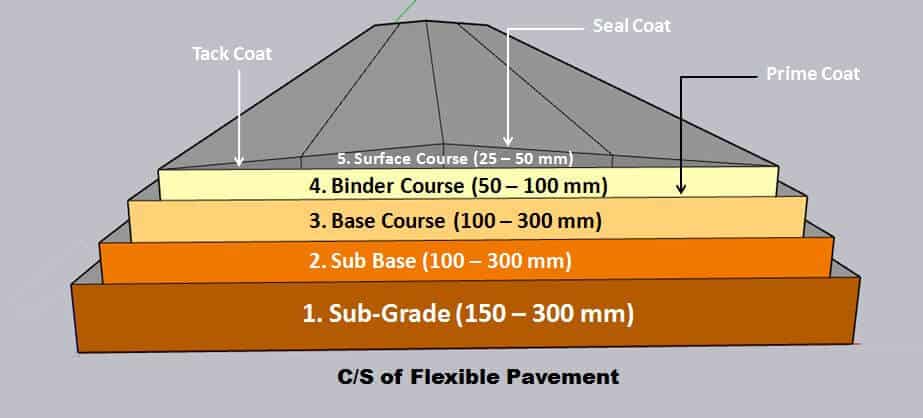Flexible Pavements in Road
Flexible pavements are those pavements that reflect the deformation of the subgrade and the subsequent layers to the surface. Flexible, usual asphalt, is laid with no reinforcement or with a specialized fabric reinforcement that permits limited flow or repositioning of the roadbed underground changes.
-The design of flexible pavement is based on load distributing characteristics of the component layers. The blacktop pavement including water and gravel bound macadam fall in this category.
-Flexible pavement, on the whole, has low or negligible flexible strength flexible in its structural action. The flexible pavement layers transmit the vertical or compressive stresses to the lower layers by grain transfer through contact points of granular structure.
-The vertical compressive stress is maximum on the pavement surface directly under the wheel load and is equal to contact pressure under the wheels. Due to the ability to distribute the stress to a large area in the truncated cone shape, the stresses get decreased in the lower layer.
-As such the flexible pavement may be constructed in many layers and the top layer has to be strongest as the highest compressive stress.
-To be sustained by this layer, also, to wear and tear, the lower layer has to take up the only lesser magnitude of stress as there is no direct wearing action due to traffic loads, therefore inferior material with a lower cast can be used in the lower layers.
The component layers of a flexible pavement laid over the subgrade are:
a)Granular sub-base and drainage layer.
b) Granular base course.
c) Bituminous binder course.
d) Bituminous surface course.
On low-volume roads or village roads the typical components of flexible pavement may consist of the following layers:
a)Granular sub-base or drainage layer.
b) Granular base course.
c) Thin bituminous surfacing.
1. Alligator cracking or Map cracking.
2. Consolidation of pavement layers.
3. Shear failure cracking.
4. Longitudinal cracking.
5. Frost heaving.
6. Lack of binding to the lower course.
7. Reflection cracking.
8. Formation of waves and corrugation.
9. Bleeding.
10. Pumping.
Components of flexible pavement:
The component layers of a flexible pavement laid over the subgrade are:
a)Granular sub-base and drainage layer.
b) Granular base course.
c) Bituminous binder course.
d) Bituminous surface course.
On low-volume roads or village roads the typical components of flexible pavement may consist of the following layers:
a)Granular sub-base or drainage layer.
b) Granular base course.
c) Thin bituminous surfacing.
Failures of Flexible pavements:
1. Alligator cracking or Map cracking.
2. Consolidation of pavement layers.
3. Shear failure cracking.
4. Longitudinal cracking.
5. Frost heaving.
6. Lack of binding to the lower course.
7. Reflection cracking.
8. Formation of waves and corrugation.
9. Bleeding.
10. Pumping.





No comments
Thank You For Your Comment.